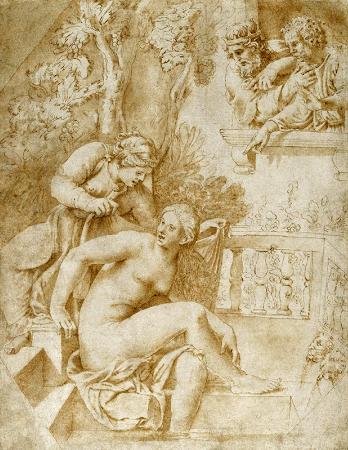Bathsheba at Bath (1654). Oil on canvas. 142 x 142. Bathsheba at Her Bath is an oil painting by the Dutch artist Rembrandt finished in 1654. A depiction that is both sensual and empathetic, it shows a moment from the Old Testament story in which King David sees Bathsheba bathing and, entranced, seduces and impregnates her. In order to marry Bathsheba and conceal his sin, David sends her husband into battle and orders his generals to abandon him, leaving him to certain death. While the scene of David spying on Bathsheba had been painted by earlier artists, Rembrandt's depiction differs in its tight pictorial focus and erotic vitality, achieved through broad, thick brushstrokes and vibrant coloration. The painting hangs in The Louvre; it is one of 583 works donated by Dr. Louis La Caze in 1869. For Kenneth Clark, the canvas is Rembrandt's greatest painting of the nude. Its insight into Bathsheba's moral dilemma has been described as one of the great achievements of western painting. The Second Book of Samuel gives the account of King David who saw a woman bathing from his palace roof. When he asked after her, he was told that she was Bathsheba, daughter of Eliam and wife of Uriah the Hittite. David had his messengers retrieve her, and after they slept together she became pregnant with his child. David was able to marry Bathsheba by sending Uriah into battle where he was killed. Prior to Bathsheba at Her Bath, the standard treatment had been to show Bathsheba bathing out of doors, thus accounting for her visibility to David, and accompanied by maidservants. A tower could usually be seen in the distance, and perhaps a small figure of David, sometimes accompanied by his two courtiers. Such was the design Rembrandt's earlier The Toilet of Bathsheba, dated 1643. By eliminating David, his messengers and most of the traditional narrative elements from the picture, the only anecdotal references included are the letter from David and the presence of an attendant drying her foot, Rembrandt's presentation of Bathsheba is both intimate and monumental. As a result, the moralistic theme of previous treatments of the subject is replaced by a direct eroticism in which the viewer supplants David as voyeur. The work is painted as life sized and in a shallow space, with Bathsheba dominating the composition as she had in no other earlier version of the scene. It is not known whether Rembrandt painted Bathsheba for his own reasons, or to satisfy a commission. Presumably in response to Rembrandt's painting, his ex-pupil and close associate Willem Drost painted Bathsheba with David's Letter the same year, which is also in the Louvre. Apart from the lack of anecdotal devices, the painting is unusual in other ways. Bathsheba is presented in a space that is difficult to read. The dark background is suggestive of night, while a massive column implies a large architectural structure. Behind her lies a passage of richly painted drapery composed of browns and ochers that impart a golden warmth. Around her rests a thickly painted background of white chemise; set against this her naked flesh stands out for its solid form and the sumptuous application of paint. The paint used to describe her figure is richly nuanced, its broad brushstrokes and strong highlights impart a vibrant tactile quality to the body, rendering her presence palpable. Bathsheba at Her Bath is a reinterpretation of two antique reliefs familiar to Rembrandt through engravings. A print by Tobias Stimmer may have been influential, as it includes the pillar, a curtain drawn across the background and Bathsheba's downcast gaze. It was begun around 1647 and altered and repainted until its completion in 1654. Originally the canvas may have been larger and of a vertical format. It might have been trimmed some ten centimeters at the left and at least 20 centimeters in height; It is speculated that Rembrandt cut the canvas himself in order to intensify the impact of the figure. show that at some point late in the painting process, he lowered Bathsheba's head from its initial more upward angle, thereby increasing the sense of the figure's withdrawal into reverie. Initially she appeared to be looking out of the corner of her eye, as if watching David; in the present version her gaze is softened, in the general direction of her maid but focused on no particular object, imparting a feeling of solemnity and contemplation. There was no letter in her hand in the original conception, and it is also possible that her lap, thighs, and right arm were once draped. Despite its classical references, the characterization of the figure is unconventional, and the depictions of her large stomach, hands and feet are derived from observation rather than respect for the idealised form.
more...




